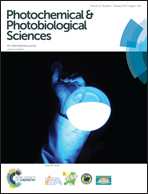Entropy production in oscillatory processes during photosynthesis
Abstract
The flow of matter and heat and the rate of enzymatic reactions are examined using two models of photosynthesis that exhibit sustained and damped oscillatory dynamics, with the objective of calculating the rate of entropy generation and studying the effects of temperature and kinetic constants on the thermodynamic efficiency of photosynthesis. The global coefficient of heat transfer and the direct and inverse constants of the formation reaction of the RuBisCO–CO2 complex were used as control parameters. Results show that when the system moves from isothermal to non-isothermal conditions, the transition from a steady state to oscillations facilitates an increase in the energy efficiency of the process. The simulations were carried out for two photosynthetic models in a system on a chloroplast reactor scale.


 Please wait while we load your content...
Please wait while we load your content...